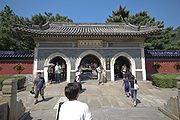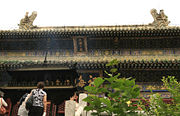
Tanzhe Temple
Encyclopedia

Western Hills
The Western Hills refers to the hills and mountains in the western part of Beijing.- Geography :Being an extension of the Taihang mountain range from Hebei Province, the Western Hills cover about 17% of Beijing municipality including most of Mentougou and Fangshan Districts as well as parts of...
, a mountainous area in western Beijing
Beijing
Beijing , also known as Peking , is the capital of the People's Republic of China and one of the most populous cities in the world, with a population of 19,612,368 as of 2010. The city is the country's political, cultural, and educational center, and home to the headquarters for most of China's...
. It is one of the most well-known temples in Beijing. At one time, it was one of the most important temples in the nation. The temple is located near China National Highway 108
China National Highway 108
China National Highway 108 is a National Highway which connects Beijing through Chengdu to Kunming. In Beijing it is known as Jingyuan Road....
in the Mentougou District
Mentougou District
Mentougou District is in west Beijing.Spanning 1,321 square kilometres, with 266,591 inhabitants , it is subdivided into 4 subdistricts of the city proper of Beijing and 9 towns ....
of Beijing.
Built in the Jin Dynasty
Jìn Dynasty (265-420)
The Jìn Dynasty , was a dynasty in Chinese history, lasting between the years 265 and 420 AD. There are two main divisions in the history of the Dynasty, the first being Western Jin and the second Eastern Jin...
(265–420), it has an age of around 1,700 years. The area of the entire temple is 100 mu (6.8 hectares), and its arrangement of halls is akin to that found in the Ming
Ming Dynasty
The Ming Dynasty, also Empire of the Great Ming, was the ruling dynasty of China from 1368 to 1644, following the collapse of the Mongol-led Yuan Dynasty. The Ming, "one of the greatest eras of orderly government and social stability in human history", was the last dynasty in China ruled by ethnic...
and Qing
Qing Dynasty
The Qing Dynasty was the last dynasty of China, ruling from 1644 to 1912 with a brief, abortive restoration in 1917. It was preceded by the Ming Dynasty and followed by the Republic of China....
dynasties. Tanzhe Temple is one of the oldest temples in Beijing.
Most of the existing buildings in the temple are from the Ming and Qing dynasties, and there are pagodas from various historical periods such as the Jin, Yuan, Ming and Qing dynasties. The two "Emperor trees" by the Hall of Three Sages were planted during the Liao Dynasty
Liao Dynasty
The Liao Dynasty , also known as the Khitan Empire was an empire in East Asia that ruled over the regions of Manchuria, Mongolia, and parts of northern China proper between 9071125...
about 1,000 years ago.
The spacious and imposing buildings are arranged in three main northsouth axes. Along the central axis are the Archway, the Front Gate, Deveraja Hall, Mahavira Hall and Vairochana Pavilion.

Mahavira
Mahāvīra is the name most commonly used to refer to the Indian sage Vardhamāna who established what are today considered to be the central tenets of Jainism. According to Jain tradition, he was the 24th and the last Tirthankara. In Tamil, he is referred to as Arukaṉ or Arukadevan...
Hall. 24 metres in length, 33 metres wide. Buddhist monks regularly perform religious ceremony here.
The temple is divided between the Hall of Abstinence, the Ordination Altar and the Hall to Guanyin. The latter has received fame because of its association with princess Miaoyan, daughter of Kublai Khan
Kublai Khan
Kublai Khan , born Kublai and also known by the temple name Shizu , was the fifth Great Khan of the Mongol Empire from 1260 to 1294 and the founder of the Yuan Dynasty in China...
. The princess is said to have entered the nunnery here in the 13th century. The indentations can be found on the stone on which she always knelt and prayed within the hall. Supposedly she was also buried within the temple compound.
To the right of the main courtyard lies a separate yard containing stone monuments built in different styles over a period of several centuries and housing the remains of eminent monks.

